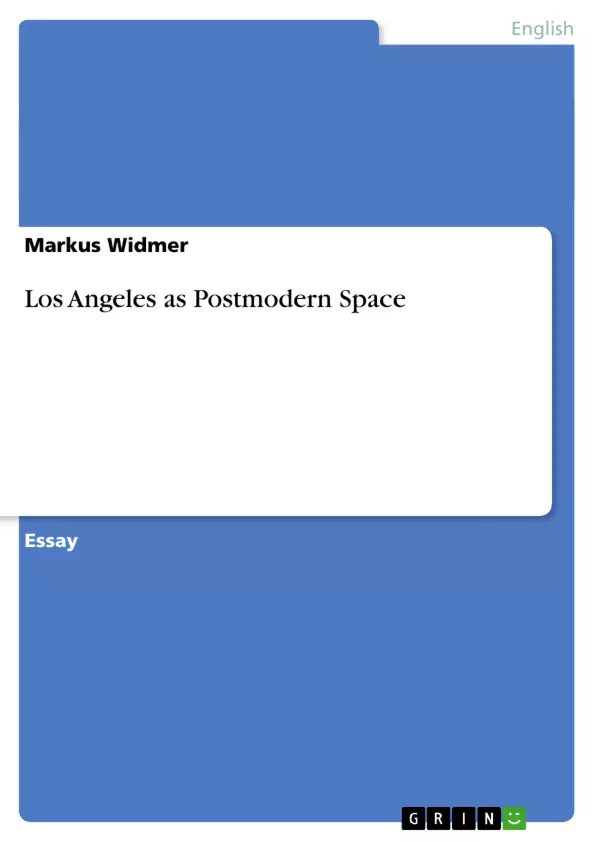Edward W. Soja called Los Angeles ‘the quintessential postmodern metropolis’. This, however, shall not be the premise of my argument in this essay, because of the obvious danger of circularity. Yet I will use postmodern critics and compare my findings to postmodern models of culture, space and society. I will not discuss the term postmodernism itself, simply because the range of this essay does not allow my entering this ongoing debate. The term will be used as denoting both a period, beginning, for my purposes, in the 1960s, and a theory of cultural tendencies in contemporary life. For this essay, I will assume that postmodernism is a fact, a part of everyday reality, and that it differs substantially from modernism. The main body of this essay will consist of a discussion of the fundamental factors which define Los Angeles as postmodern space. I will focus on particularities that distinguish Los Angeles from other cities, most of all from those which have not yet crossed the threshold of postmodernity. Firstly, I will investigate the geographical instability of the city; the fact that it is threatened to be annihilated by natural forces such as earthquakes and the desert. Secondly, I will address the idea of the city as a desert, its horizontality, its vastness, its lack of centre. Thirdly, the structure on this flat surface will be addressed; the freeways as an arterial network, and the structure of segregating walls, both literal and metaphorical. Finally, I will conclude by investigating the parallels between the idea of instability that underlies all of the factors I discuss, and the notion of the unstable in postmodernism.
Inhaltsverzeichnis (Table of Contents)
- Introduction
- 1. Instability
- 2. Horizontality
- 3. Segregation
Zielsetzung und Themenschwerpunkte (Objectives and Key Themes)
This essay examines the characteristics that define Los Angeles as a postmodern space, drawing on postmodern theories of culture, space, and society. It avoids delving into the debate on postmodernism itself, focusing instead on its tangible manifestations in the urban landscape of Los Angeles.
- The geographical instability of Los Angeles, its vulnerability to natural forces like earthquakes and the desert.
- The concept of Los Angeles as a desert, its horizontality, vastness, and lack of a defined center.
- The structural elements of this flat surface, including the freeway network and the presence of segregating walls, both physical and metaphorical.
- The parallels between the concept of instability underlying these factors and the broader notion of instability in postmodernism.
Zusammenfassung der Kapitel (Chapter Summaries)
- Introduction: Establishes Los Angeles as a quintessential postmodern metropolis and outlines the essay's focus on defining Los Angeles as postmodern space. It introduces the key themes: geographical instability, horizontality, and segregation, and outlines the essay's approach to connecting these themes with postmodern concepts.
- 1. Instability: Highlights the inherent instability of Los Angeles due to its location on a geological fault and its dependence on water resources. The essay discusses the constant threat of earthquakes and the impact of drought, drawing on examples from films and literature.
- 2. Horizontality: Explores the feeling of vastness and lack of fixedness in Los Angeles, exemplified by the city's sprawling landscape and the "limitless horizontality" that characterizes its urban structure. The essay connects this sense of horizontality to the idea of the desert and draws on theories from Baudrillard to illustrate its postmodern implications.
- 3. Segregation: Examines the structured surface of Los Angeles, focusing on the freeway network as a defining element of its urban landscape. The essay compares the structure of city cells connected by freeways to the postmodern concept of society in an information age, highlighting the connections between physical space and social structures.
Schlüsselwörter (Keywords)
The primary keywords of this essay encompass the characteristics of Los Angeles as a postmodern space, including geographical instability, horizontality, segregation, and the influence of postmodern theory on understanding these spatial features. These keywords reflect the essay's focus on the city's unique physical landscape and its relationship to broader cultural and societal trends.
- Quote paper
- Mag. Markus Widmer (Author), 1998, Los Angeles as Postmodern Space, Munich, GRIN Verlag, https://www.grin.com/document/14781



